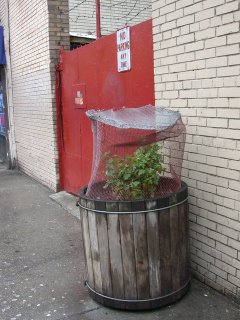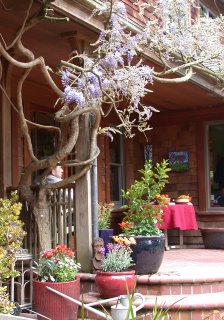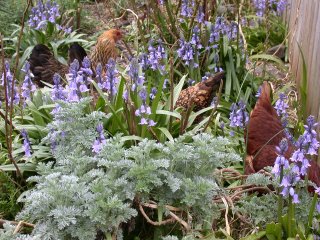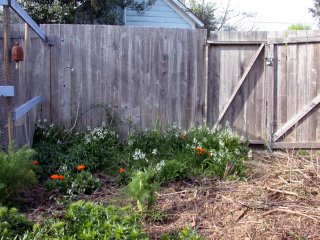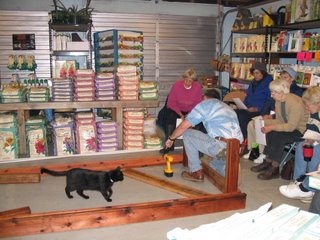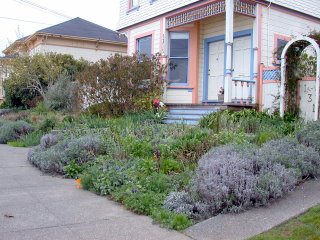Sign of the Shovel has sparked a discussion of the relative merits of gardening with a spouse vs. gardening alone. She wonders briefly if she should have married a man like
Eliot Coleman: "Eliot, are you the man I should have married? Someone who'd actually work the soil with me? Side by side, shovel to shovel? Think of the gardens I could make with a man like you! Alas, I suppose I knew what I was doing when I favored sex and conversation over any interest in gardening all those years ago."
Not me, girlfriend. I like to garden ALONE. I do not have the least bit of interest in sharing the garden with my beloved husband. I don't want to compromise, I don't want to share, I don't want to work together or cooperate. I want to do MY THING. Fortunately, that's just fine with him. He gets to make a request now and then (an apple tree, some raspberries), but that's as far as it goes.
Here's the problem with couples who garden together. You've all seen this, I'm sure: a couple strolling through the nursery on a Saturday morning, hand in hand. They look happy, relaxed. The week is behind them, and they can look forward to a peaceful weekend together. They have decided to spend their Saturday working in the garden.
Just then, one of them stops to sniff a climbing jasmine. (For the sake of gender neutrality, let's call her--or him--Kelly). With a dreamy expression, Kelly chooses the tallest, most fragrant vine and places it in the red wagon they've been towing behind them. The other (we'll call him--or her--Alex) looks puzzled. "Honey, where are we going to put that?"
The spell is broken, but Kelly tries to be patient. "Well, I thought maybe by the fence."
"The one at the back? Where the red thing is?"
"No, the other one, next to where the datura died last year."
"What's a datura?"
Kelly sighs, that long, exasperated sigh that Alex knows all too well. "Never mind. This wasn't a good idea. Let's just go." Kelly drops the handle of the red wagon and begins to walk to the car.
Alex follows, confused and forlorn. "Honey, wait. I just don't know what the plan is. I'm not in on the program."
Kelly stops, and looks up at the sky for a moment as if counting to ten. "There IS no plan, Alex. Why does there always have to be a plan with you? I just want to wander around and...oh, never mind."
And with that, Kelly and Alex head to the car. Their big gardening weekend? Over.
I observe these interactions every weekend as I wander through the nursery, blissfully alone. No, I have not forsaken love in the name of gardening solitude. It just so happens that my beloved had the wisdom to recognize, years ago, that our garden wasn't big enough for the both of us. I need a place where I can be alone, a place where I can do as I please. And so, as a gardener, I am single and I love it.
On my solitary wanderings through the nursery, I can linger over the creeping thyme as long as I want. I can stumble across a pair of scabiosa on the sale table and decide, on the spot and without consulting anyone, to plant a butterfly garden. On the way to the cash register, I might see a blood-red penstemon and change my mind, deciding that what I really need is a hummingbird garden. I can spend the rest of the afternoon putting away my butterfly plants and looking for hummingbird plants. No one starts to get bored and restless. No one begs to go home.
It is the gardening equivalent of eating crackers in bed. Ah, the pleasures of the single life.
Not everyone gardens alone, however. Some of us choose to garden with our mate. And so, unencumbered by any personal expertise or professional advice, I present the first-ever Gardening Quiz for Couples. Take this test with your sweetheart--if you dare.
1. At the nursery, you find your better half in the pest control section, eyeing the box of gopher poison with the little pictures of furry brown animals doubled over in pain. You:
a. Scream, "What kind of monster ARE you?" and run crying to the car
b. Sniff haughtily and say, "I hope for your sake that the rumors of a gopher coup are completely untrue. Revenge, as they say, will be sweet."
c. Suggest that, since your sweetie got to choose which parking space to park in, perhaps YOU should get to choose the method of gopher control.
2. After the third or fourth hour at the nursery, your loved one suggests that perhaps it's time to make some purchases and go home. You:
a. Roll your eyes and say, "Oh, GREAT. We just got here, and already you want to leave. Every time we do something that I want to do, you start complaining that you're bored!"
b. Send your beloved off in search of a double peach datura, ensuring at least another hour of solitude.
c. Answer cheerfully, "Great! Let's go home and tackle those weeds!"
3. You come home one day to find that your significant other has mowed your newly planted Wildflower Meadow down to a clean-shaven, 1-inch lawn. You:
a. Jump up and down in the rose garden shouting, "Let's cut THESE down too! Or-wait, those FRUIT TREES are looking a bit gangly! Where's the chainsaw? Let's make ALL our plants one inch high!"
b. Stick a tag on the lawn mower at your next garage sale, and when your better half isn't looking, sell it for the price of a pound of Spring Meadow Wildflower Seed.
c. Look out at the “lawn” and say brightly, “Ah, I see you noticed the problem with the Wildflower Meadow too. Not enough bachelor buttons, and too many poppies. Looks like you’ve got it all ready to replant.”
Scoring: Give yourself one point for every "a", 2 points for every "b", and 3 points for every "c" that you selected.
If your score totaled 3-4: Gardening may not be the best hobby for you and your loved one to share. Try looking for another activity you can do together, like fencing or kickboxing.
If your score totaled 5-7: There may be room for compromise in your gardening relationship. Remember that Laverne & Shirley episode where they got in a big fight and split their entire apartment down the middle with masking tape? Get out in the garden and give it a try.
If your score totaled 8-9: Congratulations! You have gained the upper hand in the gardening relationship. You and your beloved can enjoy many happy hours together in the garden and feel safe in the knowledge that, as long as you continue to hold your rightful place as Queen of the Garden, no one gets hurt.
 I'll say this about the island of Manhattan: all that concrete and steel makes you appreciate the smallest attempts at horticulture--whether it's a flowering plant in an urn on a stoop...
I'll say this about the island of Manhattan: all that concrete and steel makes you appreciate the smallest attempts at horticulture--whether it's a flowering plant in an urn on a stoop...
 the tulips in front of the New York Public Library...
the tulips in front of the New York Public Library...
